Almost 700,000 to Lose Food Stamp Benefits Under Finalized Trump Administration Rule

In this Friday, March 17, 2017, file photo, a sign advertises a program that allows food stamp recipients to use their EBT cards to shop at a farmer's market in Topsham, Maine. AP Photo/Robert F. Bukaty
A new USDA rule, one of several that has been under consideration, would make it more difficult for states to obtain work requirement waivers for the federal food stamp program.
The Trump administration on Wednesday gave final approval to a rule that will restrict states’ ability to waive federal work requirements for food stamps, a move expected to cause nearly 700,000 adults to lose access to the program.
The announcement by the U.S. Department of Agriculture comes after the agency received thousands of comments on the rule, which were overwhelmingly opposed to the change.
Current rules limit the length of time that adults under the age of 50, who are not disabled and have no children, can receive food stamps to three months during a three-year-period unless they work at least 20 hours a week. States are able to waive the three-month time-limit in communities with either 10% unemployment or a lack of sufficient jobs.
But the new policy would make it more difficult for states to obtain those waivers. To qualify under the new rule, a community would need to have an unemployment rate above 6% for the previous two years and the rate would need to be at least 20% the national average.
Approximately 1.1 million adults would be subject to the time limit and would need to either get jobs or enroll in job training by April 1 to avoid losing access to the Supplemental Nutrition Assistance Program (SNAP). The USDA estimates that 688,000 people would be unable to meet the work requirement and lose SNAP benefits.
States’ current waivers will only be valid through March 31, and after that they will have to submit new waivers for consideration. The USDA estimates that 77 percent of counties with waivers would lose them.
USDA Secretary Sonny Perdue said that with low unemployment and a strong economy, states don’t need to keep providing this benefit to people who could work.
“Government can be a powerful force for good, but government dependency has never been the American dream,” Perdue said. “We need to encourage people by giving them a helping hand but not allowing it to become an indefinitely giving hand.”
The rule will reduce federal spending by $5.4 billion over the next five years, according to the USDA. However, states may see a slight increase in costs associated with verifying work hours and exemptions.
Policy experts said the rule, in addition to causing harm to poor residents who are unable to find work, could exacerbate the effects of any future economic recession.
States are currently able to request waivers when they are experiencing a rapid rise in unemployment, said Robert Greenstein, president of the Center on Budget and Policy Priorities. But the new rule would require states to rely on historical unemployment data, which “would not reflect the onset of economic downturns until many months later,” he said.
“A state with spiking unemployment reaching levels as high as 9% would not qualify for a waiver if national unemployment were also high, such as at 8%” Greenstein said. “This will limit a core strength of SNAP — its responsiveness to changes in economic conditions so that individuals who lose their source of income can quickly qualify for temporary food assistance.”
Nearly every state has used a waiver at one time or another, according to Ellen Vollinger, legal director for the Food Research and Action Center.
While the unemployment rate stood at 3.6% in October, volatility in the workforce at the local level could make it harder for food stamp recipients in certain communities to comply with the work requirements, she said. In certain communities, it is unlikely that those removed from the SNAP program will be able to find jobs, Vollinger said. Rather, she said, it will simply be harder for them to put food on the table.
“It has an impact on all kinds of communities, rural as well as urban,” Vollinger said of the rule change. “It’s going to hit very needy people who are struggling in all parts of the country.”
Not only will those communities that currently use waivers be affected, but if the rule stands, it will impact other communities in the future.
“It means in the future as economic conditions might warrant getting waivers, this is going to make it very hard for that to happen,” she said.
The rule is one of three recent changes the Trump administration has proposed to food eligibility requirements, which taken altogether are expected to eliminate benefits for around 4 million people, or approximately 10 percent of those currently enrolled in the program.
Other proposals would do away with automatic SNAP enrollments for those on welfare, and alter the way utility costs are factored into the SNAP benefit analysis. Those proposals are still being evaluated.
Andrea Noble is a staff correspondent with Route Fifty.
NEXT STORY: Newark Mayor Sues New York City Over Relocation of Homeless Population to New Jersey





